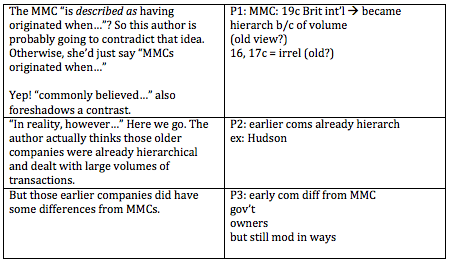-
Target Test Prep 20% Off Flash Sale is on! Code: FLASH20
Redeem
Get Ready to Rumble: GMAT RC Start to Finish - Part 1
 Weve done a lot of RC over the years, but a passage contains so much text that I rarely do a full passage with all of its questions.
Weve done a lot of RC over the years, but a passage contains so much text that I rarely do a full passage with all of its questions.
Were going to remedy that, starting today! First, well talk about the passage below (from the free problem set that comes with GMATPrep). Then, well tackle the series of questions that comes with it.
Give yourself approximately 2.5 to 3 minutes to read the below and make yourself a light Passage Map.
* The modern multinational corporation is described as having originated when the owner-managers of nineteenth-century British firms carrying on international trade were replaced by teams of salaried managers organized into hierarchies. Increases in the volume of transactions in such firms are commonly believed to have necessitated this structural change. Nineteenth-century inventions like the steamship and the telegraph, by facilitating coordination of managerial activities, are described as key factors. Sixteenth- and seventeenth-century chartered trading companies, despite the international scope of their activities, are usually considered irrelevant to this discussion: the volume of their transactions is assumed to have been too low and the communications and transport of their day too primitive to make comparisons with modern multinationals interesting.
In reality, however, early trading companies successfully purchased and outfitted ships, built and operated offices and warehouses, manufactured trade goods for use abroad, maintained trading posts and production facilities overseas, procured goods for import, and sold those goods both at home and in other countries. The large volume of transactions associated with these activities seems to have necessitated hierarchical management structures well before the advent of modern communications and transportation. For example, in the Hudsons Bay Company, each far-flung trading outpost was managed by a salaried agent, who carried out the trade with the Native Americans, managed day-to-day operations, and oversaw the posts workers and servants. One chief agent, answerable to the Court of Directors in London through the correspondence committee, was appointed with control over all of the agents on the bay.The early trading companies did differ strikingly from modern multinationals in many respects. They depended heavily on the national governments of their home countries and thus characteristically acted abroad to promote national interests. Their top managers were typically owners with a substantial minority share, whereas senior managers holdings in modern multinationals are usually insignificant. They operated in a preindustrial world, grafting a system of capitalist international trade onto a premodern system of artisan and peasant production. Despite these differences, however, early trading companies organized effectively in remarkably modern ways and merit further study as analogues of more modern structures.
What did you get out of the passage? My thoughts (by paragraph) are on the left and my notes are on the right:
I included the info on the left so that youd see how I was thinking about the passage as I read. Note that I focused on the big picture as well as contrasts. I paid attention to language that foreshadowed where the author might be going with her message.
I didnt write much about the detailsbecause I didnt think much about the details. I did read all of the sentences, but as I was reading the example about the Hudson Bay Company, for instance, I was just thinking, Okay, this is an example of an early company that still had a lot of hierarchy going on. I dont care exactly how that hierarchy functioned. I care only that this example is used to support the big idea that early companies did, indeed, have a hierarchy.
Thats your goal on the initial read-through: understand the big ideas and leave the details for later.
We (Manhattan Prep) call the notes a Passage Map because theyre designed to help you figure out where to go when answering a specific question. The goal is not to write down all of the detailsits an open book test! You can go find and re-read the details any time you want! The trick is to be able to find the relevant details quickly.
Okay, if you feel comfortable with all of that, then click here to answer your first question (you can skip down the article until you get to the problem). Keep this page open, though, so that you have the full passage text.
If you want more practice reading and taking effective notes, Ive got another article for you.
Join me next time, when well dive into more questions from this passage.
Key Takeaways for Reading Comprehension
(1) Your first read-through is designed to get the big picture, not all of the nitty-gritty details. Worry about those later (and only when you actually get a question about that detail!).
(2) Do create a Passage Map to help you navigate around the passage while answering questions. Some people are able to keep this Map in their heads, but most of us have to jot down at least a few words.
(3) If you hit something that throws you for a loop, assess: is it the first sentence of a paragraph? Does it seem like a big-picture message? If so, read that sentence again and try to pick it apart to get to the core message, using your SC skills. If, on the other hand, the sentence is just detail, skip it for now (and possibly forever).
* GMATPrepquestions courtesy of the Graduate Management Admissions Council. Usage of this question does not imply endorsement by GMAC.
Recent Articles
Archive
- May 2024
- April 2024
- March 2024
- February 2024
- January 2024
- December 2023
- November 2023
- October 2023
- September 2023
- July 2023
- June 2023
- May 2023
- April 2023
- March 2023
- February 2023
- January 2023
- December 2022
- November 2022
- October 2022
- September 2022
- August 2022
- July 2022
- June 2022
- May 2022
- April 2022
- March 2022
- February 2022
- January 2022
- December 2021
- November 2021
- October 2021
- September 2021
- August 2021
- July 2021
- June 2021
- May 2021
- April 2021
- March 2021
- February 2021
- January 2021
- December 2020
- November 2020
- October 2020
- September 2020
- August 2020
- July 2020
- June 2020
- May 2020
- April 2020
- March 2020
- February 2020
- January 2020
- December 2019
- November 2019
- October 2019
- September 2019
- August 2019
- July 2019
- June 2019
- May 2019
- April 2019
- March 2019
- February 2019
- January 2019
- December 2018
- November 2018
- October 2018
- September 2018
- August 2018
- July 2018
- June 2018
- May 2018
- April 2018
- March 2018
- February 2018
- January 2018
- December 2017
- November 2017
- October 2017
- September 2017
- August 2017
- July 2017
- June 2017
- May 2017
- April 2017
- March 2017
- February 2017
- January 2017
- December 2016
- November 2016
- October 2016
- September 2016
- August 2016
- July 2016
- June 2016
- May 2016
- April 2016
- March 2016
- February 2016
- January 2016
- December 2015
- November 2015
- October 2015
- September 2015
- August 2015
- July 2015
- June 2015
- May 2015
- April 2015
- March 2015
- February 2015
- January 2015
- December 2014
- November 2014
- October 2014
- September 2014
- August 2014
- July 2014
- June 2014
- May 2014
- April 2014
- March 2014
- February 2014
- January 2014
- December 2013
- November 2013
- October 2013
- September 2013
- August 2013
- July 2013
- June 2013
- May 2013
- April 2013
- March 2013
- February 2013
- January 2013
- December 2012
- November 2012
- October 2012
- September 2012
- August 2012
- July 2012
- June 2012
- May 2012
- April 2012
- March 2012
- February 2012
- January 2012
- December 2011
- November 2011
- October 2011
- September 2011
- August 2011
- July 2011
- June 2011
- May 2011
- April 2011
- March 2011
- February 2011
- January 2011
- December 2010
- November 2010
- October 2010
- September 2010
- August 2010
- July 2010
- June 2010
- May 2010
- April 2010
- March 2010
- February 2010
- January 2010
- December 2009
- November 2009
- October 2009
- September 2009
- August 2009
